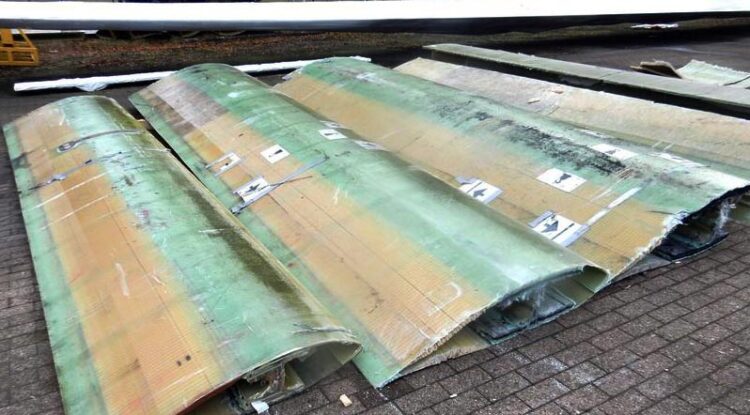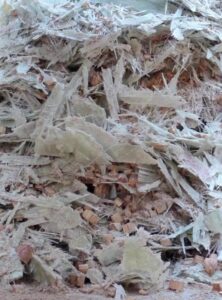Sustainable management and disposal: rotor blades

The design of a closed-loop, economically feasible disposal strategy is essential for establishing scientifically mature processes for the recycling of rotor blades in the future.
© Fraunhofer IWES_Fraunhofer WKI
In collaboration with the Institute for Energy, Recycling and Environmental Protection (IEkrW) at Bremen University of Applied Sciences, the Fraunhofer Institute for Wind Energy Systems IWES is developing comprehensive concepts aimed at making it possible to recycle and reuse rotor blades considerably better in the future.
The aim of the “Concept for recycling and reuse of rotor blades made of plastic composite materials” project – KoReNaRo for short – is to set up an economically feasible disposal strategy allowing as high a recycling quota as possible and thereby enabling a sustainable circular economy. The project is being funded to the tune of €150,000 in the scope of the German Federal Ministry of Education and Research’s (BMBF) “Research for Sustainable Development – FONA3” program and was launched in October 2021. The funding is currently for the conceptual design of a demonstration system. A decision will then be taken on whether implementation should be funded in a second phase.

© Fraunhofer WKI
To date, almost 30,000 wind turbines with a total output of more than 50 gigawatts (GW) have been erected in Germany. The new German government has announced that it aims to achieve climate neutrality by 2045. This will also involve new expansion targets for wind energy: around 70 GW more should be installed in offshore farms alone by 2045. At the same time, the Renewable Energy Law (EEG) subsidy for some existing onshore wind turbines ended last year, and some of them are now to be taken out of operation. For end-of-life (EOL) wind turbines no longer in operation, the recycling concepts currently available on the market are to be optimized or further developed towards a more circular economy. The focus here is in particular on how rotor blades can be recycled more efficiently, economically, and ecologically.
High-quality recycling for fiber composite materials
The scientists are aiming to develop a higher-quality recycling system for the entire EOL rotor blade. The important aspect is first of all to design an automated initial treatment for this, whereby the rotor blade can be more effectively dismantled and separated into its individual components. This creates recycling loops, increases the recycling rate, and saves costs. One possible location for a recycling station would be Bremerhaven.
“Bremerhaven wants to establish itself as a location for the disposal or recycling of wind turbines at an early stage. A study was recently commissioned in which the market segment was examined in greater detail and an initial logistics and disposal concept for onshore and offshore wind turbines was drawn up in order to be able to approach potentially interested companies with it,” says Dipl.-Ing. Nils Schnorrenberger, Managing Director of the Bremerhaven business development company BIS.
Another goal of the research project is to reuse the spar caps – which give the rotor blade its stability – from the rotor blades for other workpieces, preserving the existing good material characteristics as far as possible. That represents a challenge, as they are made up of centimeter-thick layers of glass fiber and carbon fiber composites.
The approach of recovering the high-quality glass fibers from the thick-walled flange and cap materials by means of slow-batch pyrolysis is also to be pursued further. The synthesis gases generated in this process can then be further utilized, among other things for energy or hydrogen production. The cost-efficiency and feasibility of this special process should be verified in the project using a test system.
For the sandwich components in the rotor blade, balsa wood and plastic foams, already known methods are to be rolled out on a large scale, in particular for recycling the balsa wood as wood foam.
Project coordinator Dr.-Ing. Steffen Czichon, Head of Department Rotor Blades at Fraunhofer IWES, explains: “Holistic conceptualization is important to create a sustainable recycling concept for rotor blades that gives the wind industry a clear framework to create a competitive market for secondary products and disposal. For this, we need concrete implementation strategies. In the KoReNaRo research project, we at Fraunhofer IWES contribute our comprehensive competencies in component and material testing as well as our many years of experience in rotor blade development and manufacturing.”
Dr. Detlef Spuziak-Salzenberg, project manager at the Institute for Energy, Recycling and Environmental Protection (IEkrW), adds: “We have been able to impart our experience in batch pyrolysis, waste management, and the disposal market, especially also for the wind energy sector, into the KoReNaRo project in a profitable and targeted manner. These are fundamental components and steps for the validation of the new recycling methods for rotor blades.
The concept phase is followed by the implementation phase, where the research partners Fraunhofer IWES and IEkrW hope to realize the individual work steps together with cooperation partners. The planning of a recycling station should also be advanced in collaboration with an industry consortium.
Recycling procedures used until now
Accounting for approx. 97% of the total weight, concrete and steel make up the lion’s share of a wind turbine and can also be well recycled. However, there are also other materials in rotor blades and the cladding of the hub and nacelle: fiber composites with carbon and glass fibers.
The rotor blades and cladding removed during the dismantling of turbines are sawed into smaller pieces directly on site and transported away. The materials containing carbon are always neatly separated from the other material flows in order not to affect their recycling paths. The thick-walled flange areas with the metal bolts and metal sleeves also require separate processing for metal separation. What remains is the main part of the rotor blades with its matrix of glass fiber-reinforced plastic resins (GRP), including the so-called sandwich materials such as balsa wood and/or plastic foams made of PVC or PET.
This material mix is currently usually shredded in a further processing step and used in the cement industry, substituting fossil fuel and mineral raw materials such as sand and chalk.
The carbon-reinforced plastic resins (CFRP) components are recycled by means of large-batch pyrolysis, in which the plastic contained is thermally decomposed and the fibers can be recovered. These can be processed into new non-woven materials, for example, or ground and employed in injection molding.
Currently, the initial treatment and recycling of rotor blades is largely based on the experience gained by dismantling companies: the first specific dismantling projects have been under way since 2019. A market for new secondary products now has to be developed or tapped. This is precisely where the KoReNaRo research project comes in.
Fraunhofer IWES
Fraunhofer IWES secures investments in technological developments through validation, shortens innovation cycles, accelerates certification procedures, and increases planning accuracy by means of innovative measurement methods in the wind energy and hydrogen technology sectors. At present, there are more than 300 academics and employees as well as around 150 students employed at the seven sites: Bremen, Bremerhaven, Görlitz, Hamburg, Hannover, Leuna, and Oldenburg.
https://www.iwes.fraunhofer.de/
IEkrW
The institute’s goal is to develop solution concepts that make both ecological and economic sense for specific questions regarding the circular economy and environmental protection. As a research institute at Bremen University of Applied Sciences, the institute serves as an interface between business and science.
https://www.IEKrW.de
BIS
BIS (Bremerhavener Gesellschaft für Investitionsförderung und Stadtentwicklung mbH) is responsible for the development, strengthening, and marketing of Bremer-haven as a business location. The range of services on offer includes support for resident or new companies, management of commercial sites and real estate, advice regarding funding and approval procedures, infrastructure development, supraregional site marketing, and cluster and network work.
https://bis-bremerhaven.de
Wissenschaftliche Ansprechpartner:
Contact partners at the Fraunhofer Institute for Wind Energy Systems IWES
Project Coordination: Steffen Czichon, Head of Department Rotor Blades
Tel.: +49 (0)471 14290-383
E-mail: steffen.czichon@iwes.fraunhofer.de
www.iwes.fraunhofer.de
Project Coordination: Niels Ludwig, Senior Engineer, Rotor Blades Department
Tel.: +49 (0)471 14290-398
E-mail: niels.ludwig@iwes.fraunhofer.de
www.iwes.fraunhofer.de
Contact partners at Institut für Energie und Kreislaufwirtschaft an der Hochschule Bremen GmbH
Prof. Dr. Martin Wittmaier
+49 (0)421-5905-2326
wittmaier@hs-bremen.de
www.IEKrW.de
Dr. Detlef Spuziak-Salzenberg
+49 (0)421-5905-2326
d.spuziak-salzenberg@iekrw.de
www.IEKrW.de
Media Contact
All latest news from the category: Ecology, The Environment and Conservation
This complex theme deals primarily with interactions between organisms and the environmental factors that impact them, but to a greater extent between individual inanimate environmental factors.
innovations-report offers informative reports and articles on topics such as climate protection, landscape conservation, ecological systems, wildlife and nature parks and ecosystem efficiency and balance.
Newest articles

Innovative 3D printed scaffolds offer new hope for bone healing
Researchers at the Institute for Bioengineering of Catalonia have developed novel 3D printed PLA-CaP scaffolds that promote blood vessel formation, ensuring better healing and regeneration of bone tissue. Bone is…

The surprising role of gut infection in Alzheimer’s disease
ASU- and Banner Alzheimer’s Institute-led study implicates link between a common virus and the disease, which travels from the gut to the brain and may be a target for antiviral…

Molecular gardening: New enzymes discovered for protein modification pruning
How deubiquitinases USP53 and USP54 cleave long polyubiquitin chains and how the former is linked to liver disease in children. Deubiquitinases (DUBs) are enzymes used by cells to trim protein…



